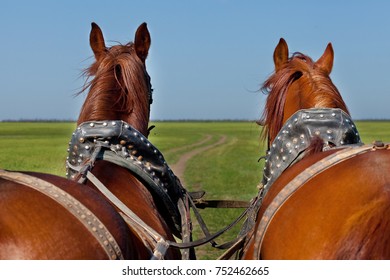
“How did we end up with this crazy food that adult humans aren’t meant to digest,” she asks, “and how have we made it work?” Dairying, well-studied in Western European cultures, was once thought to have spread alongside a genetic mutation that makes it possible to digest lactose, a milk sugar, into adulthood. Warinner is using plaque analysis, together with “a little genetics, a bit of microbiology, history, social archaeology, and ethnography” to pursue a larger goal: understanding the origins and global spread of dairying.


In addition, the specific amino acid sequences of the recovered milk proteins act as a kind of fingerprint that can reveal which livestock species were being milked. In 2014, she and her colleagues showed that milk proteins can become trapped in calcifying human dental plaque, enabling researchers to determine when livestock milk first began appearing in human diets.
#Horse drawn cart cow tied behind archive
Ancient tartar, once discarded, is now regarded by archaeologists as a vital archive that preserves individuals’ DNA, their oral microbiome, and traces of what they ate-all thanks to Warinner, who first began exploring its potential while a Harvard graduate student. “Dental calculus is fascinating because it’s like the kitchen sink-a time capsule of your mouth and everything that goes into it,” says assistant professor of anthropology Christina Warinner, who is also a Seaver assistant professor at the Radcliffe Institute. And the record showing the origin, extent, and diversity of this custom lies in a durable and extraordinarily representative source: ancient dental plaque. Now a scientist interested in reconstructing ancient diets and understanding the evolution of the human microbiome has begun to assemble new types of evidence suggesting that the ability to build a succession of empires on the Eurasian Steppe has been predicated, at least in part, on dairying: the widespread production and consumption of horse, sheep, goat, cow, and other milks and milk products that sustained and tied nomadic tribes together culturally across vast distances.

How did this nomadic culture-the third such empire to rise from the arid grasslands of the Eurasian Steppe since 200 b.c.-conquer and cohere across such vast distances? And how did these nomads’ predecessors, pastoralists with ox-drawn carts, spread swiftly east and west to forever change the genetic structure of Europe and Asia?Īnswers have been hard to come by, in part because nomadic cultures leave only limited archaeological evidence of their lifeways behind-mortuary mounds with occasional animal-bone offerings are the prime archaeological feature of the Eastern Steppe. When the sons and grandsons of Genghis Khan ruled the Mongol empire in the thirteenth century, it stretched from eastern Europe to the Pacific Ocean, and encompassed Persia in the south and Russia to the north.


 0 kommentar(er)
0 kommentar(er)
